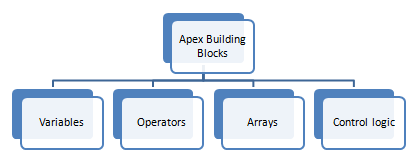If you are new to Salesforce Apex and want to Learn Apex language Basics, these are the core areas in which a beginner must concentrate and gain a full understanding. The focus should remain on these essential elements for building a strong foundation.
Apex language building Blocks ?
Apex has set of building blocks that are valuable and used in development process. Different building blocks in APEX are.
- Variables.
- Operators.
- Arrays and collections.
- Control logic.

Every developer in sales force.com must have knowledge on every syntax of apex operators. In Apex we have many other topic to be learned they are
- Triggers.
- Custom user Interface.
- Integration with external systems.
- Apex Governor Limits.
- And many more…
As already we have learned about Apex Governor limits in our previous Sales force article refer that.
Introduction to Apex Language Basics
- Data Types and Variables: Learn Apex data types such as
Integer,String, andBoolean, as well as collections likeList,Set, andMap. These basics are crucial for effectively managing data within Salesforce. - Control Structures: Get familiar with basic control structures such as loops (
for,while), conditionals (if,else), and switches. These are foundational for writing logic in Apex.
Apex Object-Oriented Programming (OOP)
- Classes and Objects: Apex is an object-oriented language, so understanding classes, objects, methods, and properties is essential. Practice creating classes, defining methods, and using constructors.
- Inheritance and Interfaces: Learn how to use
extendsfor inheritance andimplementsfor interfaces to promote code reusability and apply polymorphism effectively.
Salesforce Query Languages (SOQL and SOSL)
- SOQL (Salesforce Object Query Language): SOQL is similar to SQL and is used to retrieve records from Salesforce objects. Master both simple and advanced queries.
- SOSL (Salesforce Object Search Language): SOSL allows full-text search across multiple objects. Both SOQL and SOSL are essential for querying data in Apex efficiently.
Data Manipulation Language (DML) Operations
Understand the DML operations used in Apex to manipulate data: INSERT, UPDATE, DELETE, and UPSERT. Learn to handle DML exceptions for better error management during data operations.
Triggers and Trigger Context Variables
- Apex Triggers: Triggers allow automation based on data changes in Salesforce. Learn the syntax for writing triggers and understand when to use before vs. after triggers.
- Context Variables: Familiarize yourself with context variables like
Trigger.new,Trigger.old,isInsert,isUpdate, andisDeleteto handle specific events and records within triggers.
Governor Limits and Bulkification
Governor Limits: Salesforce enforces limits to maintain efficient resource usage. Learn about SOQL and DML limits, CPU time, and heap size restrictions.
Bulkification: Write code that handles multiple records simultaneously. Avoid placing SOQL or DML statements inside loops to prevent hitting limits. Bulkification is crucial for handling large data volumes.
Exception Handling
Learn to use try, catch, and finally blocks for robust error handling. Effective exception handling is key to building reliable and maintainable Apex code.
Testing and Code Coverage
Unit Tests: Salesforce requires 75% code coverage for deployment. Write unit tests using the @isTest annotation, create test data, and validate outcomes using System.assert statements.
Use @testSetup methods to create reusable test data for multiple tests within a class, ensuring consistent test results as you develop.
Asynchronous Apex
- Future Methods: Used for tasks that don’t need immediate execution. Asynchronous methods are ideal for handling long-running operations without impacting user experience.
- Batch Apex: Batch Apex processes large volumes of data in chunks, making it useful for managing extensive datasets.
- Queueable Apex: Provides greater flexibility than future methods for complex asynchronous operations.
Conclusion
By mastering these foundational areas, you will be well-prepared to build more complex solutions within Salesforce. For further learning, consult the Apex Developer Guide and explore Salesforce Trailhead modules, which offer structured learning paths and practical exercises.
In our last Salesforce Developer Tutorial we have studied about Apex programming language introduction and their features. In this Salesforce developer Training Tutorial we are going to learn about Apex Language Building Blocks, what are the different apex language building blocks, their syntax.